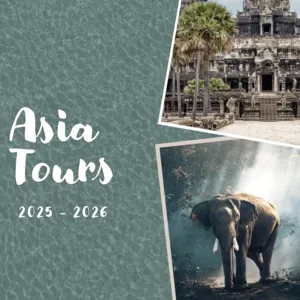Museums & Galleries Bhutan
Museums & Galleries in Bhutan: A Journey Through Culture and Art
Bhutan, often called the “Land of the Thunder Dragon,” is not only renowned for its breathtaking landscapes and vibrant festivals but also for its rich cultural heritage preserved in its museums and galleries. Exploring these institutions offers a unique window into Bhutanese art, history, and traditions. Whether you’re an art enthusiast, a history buff, or simply a curious traveler, Bhutan’s museums and galleries provide profound insights into the kingdom’s soul. Discover the essence of Bhutan through its meticulously curated collections and exhibitions.
Book Your Museums & Galleries Tour in Bhutan Now
Delving into Bhutan’s Artistic Heritage: Museums & Galleries
Bhutan’s museums and galleries are custodians of the nation’s artistic and historical legacy. From ancient artifacts to contemporary art, these venues showcase the diverse facets of Bhutanese culture. These institutions play a crucial role not just in preserving, but in actively promoting and educating both locals and visitors about the kingdom’s rich heritage. Many exhibits tell stories of Bhutan’s past, providing context and depth to the visitor experience.
The National Museum of Bhutan: A Historical Treasure Trove
One of the most prominent institutions is the National Museum of Bhutan, located in Paro. Housed in a historic watchtower, Ta Dzong, the museum’s collections include ancient Bhutanese art and artifacts, such as thangkas (religious paintings), bronze statues, and traditional costumes. The building itself, with its unique circular design, is a remarkable piece of architecture. The museum offers a comprehensive overview of Bhutanese history, making it an essential stop for any visitor. Opening hours are typically from 9 AM to 4 PM, with slight variations in winter. Admission fees are nominal, varying for locals and tourists.
Folk Heritage Museum: Experiencing Bhutanese Rural Life
Located in the capital city of Thimphu, the Folk Heritage Museum offers an immersive experience of traditional Bhutanese rural life. This living museum, set in a restored three-story traditional house, replicates a Bhutanese farmhouse from the mid-19th century. Exhibits include household objects, farming tools, and religious items, offering insight into the daily lives of Bhutanese villagers. The museum also hosts demonstrations of traditional practices, like weaving and cooking, adding to the authenticity of the experience. It’s typically open from 10 AM to 4:30 PM on weekdays and has shorter hours on weekends.
The Royal Textile Academy: Weaving the Threads of Tradition
Bhutan is famous for its intricate and vibrant textiles, and the Royal Textile Academy in Thimphu is dedicated to preserving and promoting this unique art form. The academy displays a stunning collection of antique and contemporary textiles, including royal garments and elaborate weavings. The institution also plays a crucial role in training and supporting local weavers, ensuring the continuation of this traditional craft. Visitors can watch weavers at work, learn about the different techniques and materials used, and even purchase high-quality textiles.
Address and Opening Hours
Royal Textile Academy, Thimphu, Bhutan. Open Monday to Saturday, 9 AM to 4 PM.
Contemporary Art Galleries: A Modern Perspective
While tradition is at the heart of Bhutanese art, the country also boasts a growing contemporary art scene. Several galleries in Thimphu, such as the VAST Bhutan (Voluntary Artists’ Studio, Thimphu) and Alaya Gallery showcase the works of modern Bhutanese artists. These galleries provide a platform for artists to express themselves through various mediums, reflecting the evolving cultural landscape of Bhutan. Visiting these spaces offers a contrast to the traditional art forms, highlighting the dynamism of Bhutanese creativity. Most galleries are open during standard business hours and often host special exhibitions and events.
Museums and Galleries for Every Taste
To cater to different interests, Bhutan offers a variety of museums and galleries, each with its unique charm and focus. Here are ten attractions designed to appeal to diverse preferences:
1. Most Interesting: National Museum of Bhutan
This museum, located in Paro, captures attention with its extensive collection of artifacts, including ancient thangkas, statues, and traditional masks. Its location in a historic watchtower adds to the intrigue. The museum offers a broad and fascinating overview of Bhutanese history and culture. Address: Paro, Bhutan. Opening Hours: 9 AM – 4 PM (Winter), 9 AM – 5 PM (Summer).
2. Most Piquant: The Folk Heritage Museum
This museum is unexpected, providing a glimpse into the slightly provocative or surprising aspects of traditional rural life in Bhutan. The museum’s recreation of a 19th-century farmhouse is an interactive way of life. Address: Pedzoe Lam, Thimphu, Bhutan. Opening Hours: 10 AM – 4:30 PM (Weekdays), 10:30 AM – 1 PM (Saturdays), 11:30 AM – 3:30 PM (Sundays).
3. Most Spectacular: Royal Textile Academy
Visually impressive, the Royal Textile Academy in Thimphu showcases a stunning collection of Bhutanese textiles, including royal garments. The intricate designs and vibrant colors are memorable, reflecting the artistry of Bhutanese weavers.
Address: Norzin Lam, Thimphu, Bhutan. Opening Hours: 9 AM – 4 PM (Monday to Saturday).
4. Funniest: Voluntary Artists’ Studio, Thimphu (VAST Bhutan)
While focusing on contemporary art, VAST Bhutan often features works that incorporate humor and light-heartedness, offering a refreshing and joyful experience. It leaves visitors with a sense of happiness. Address: Chang Lam, Thimphu, Bhutan. Opening Hours: Varies; check the latest schedule online.
5. Most Mysterious: Simply Bhutan Museum
Shrouded in the mystique of Bhutanese traditions, this interactive museum in Thimphu lets visitors experience local customs, rituals, and even try their hand at archery. It’s an engaging way to delve into the mysteries of Bhutanese culture. Address: Genyen Lam, Thimphu, Bhutan. Opening Hours: 9 AM – 5 PM daily.
6. Most Extreme: Gagyel Lhundrup Weaving Centre
Though not extreme in the traditional sense, this weaving center in Thimphu showcases the incredible skill and dedication required to create Bhutanese textiles, some of which take months to complete. It represents the ‘extreme’ dedication to craftsmanship. Address: Thimphu, Bhutan. Opening Hours: 9 AM – 5 PM (Monday to Saturday).
7. Most Inspiring: National Institute for Zorig Chusum
This institute in Thimphu awakens creativity by showcasing the thirteen traditional arts and crafts of Bhutan. Watching students master skills like painting, carving, and weaving inspires a desire to learn and create. Address: Pedzoe Lam, Thimphu, Bhutan. Opening Hours: 9 AM – 3:30 PM (Weekdays), closed on weekends.
8. The Most Amazing: National Library & Archives of Bhutan
Incredible in its scope, this library in Thimphu houses ancient manuscripts and religious texts, offering a unique look into the historical and spiritual foundations of Bhutan. It is beyond the usual scope of a library. Address: Pedzoe Lam, Thimphu, Bhutan. Opening Hours: 9 AM – 5 PM (Weekdays), closed on weekends.
9. The Most Atmospheric: Tango Monastery Library
With its unique energy and deep emotional mood, Tango Monastery, a short drive from Thimphu, provides a spiritual retreat where the atmosphere of ancient Buddhist learning permeates the air. The library is an integral part of this experience.
Address: Thimphu, Bhutan (near Tango Monastery). Opening Hours: Check with local guides, as access may be restricted.
10. The Most Unusual: The Bhutan Postal Museum
Standing out for its originality, this museum in Thimphu celebrates Bhutan’s unique and colorful postage stamps, which have gained international acclaim. It’s a memorable experience that’s different from typical museum visits.
Address: GPO Building, Thimphu, Bhutan. Opening Hours: 9 AM – 5 PM (Weekdays), 9 AM – 1 PM (Saturdays).
Nearby Attractions and Activities
When visiting Bhutan’s museums and galleries, you can also explore nearby attractions, enhancing your overall travel experience. Many of these sites are within easy reach and offer complementary insights into Bhutanese culture and history.
Historical Sites and Landmarks
Near the National Museum in Paro, you can visit the iconic Paro Taktsang (Tiger’s Nest Monastery), perched dramatically on a cliffside. This sacred site is a must-see for its spiritual significance and stunning views. In Thimphu, the Kyichu Lhakhang, one of the oldest temples in Bhutan, is located near the Folk Heritage Museum, offering a glimpse into ancient Bhutanese religious practices.
Parks and Natural Attractions
For nature lovers, the Royal Botanical Garden near Thimphu provides a serene escape, showcasing Bhutan’s diverse flora. The Takin Preserve, also in Thimphu, is home to the national animal of Bhutan, the Takin, offering a unique wildlife experience. These natural attractions complement the cultural insights gained from museums and galleries, providing a well-rounded experience of Bhutan.
Planning Your Visit: Practical Information
When planning a trip to Bhutan’s museums and galleries, it’s essential to consider some practical tips to ensure a smooth and enjoyable journey:
- Entry Fees: Most museums and galleries charge a nominal entry fee, which may vary for locals and tourists.
- Guided Tours: Hiring a local guide can enrich your experience, providing deeper insights into the exhibits.
- Photography: Photography policies vary; some institutions may not allow flash photography or have restrictions on certain exhibits. Always check beforehand.
- Cultural Etiquette: Dress modestly and maintain a respectful demeanor, especially when visiting religious or culturally significant sites.
High-Frequency Queries
Here are some frequently asked questions about visiting museums and galleries in Bhutan:
What is the best time to visit museums and galleries in Bhutan?
The best time to visit is during the spring (March to May) and autumn (September to November) months when the weather is pleasant and many festivals take place, providing additional cultural experiences.
Are there any discounts available for museum entry fees?
Discounts may be available for students or large groups. It’s advisable to inquire at the specific museum or gallery or check with your tour operator.
Can I purchase souvenirs at these museums and galleries?
Yes, many museums and galleries, especially the Royal Textile Academy and Folk Heritage Museum, have shops where you can buy authentic Bhutanese handicrafts, textiles, and other souvenirs.
Additional Relevant Terms
Here are some additional terms that might be relevant when exploring Bhutan’s museums and galleries:
- Dzong Architecture: The distinctive style of fortress architecture found in Bhutan.
- Thangka: Traditional Buddhist scroll paintings, often depicting deities or mandalas.
- Chorten: A Buddhist shrine, typically a stone structure containing relics.
- Lhakhang: A Bhutanese temple or monastery.
- Tshechu: Religious festivals held annually in various districts, featuring masked dances and cultural performances.
- Gho and Kira: The National Dress for Bhutanese people of all genders.
Exploring Bhutan’s museums and galleries is more than just a sightseeing activity; it’s an immersion into the heart of the kingdom’s culture, history, and artistic expression. From the ancient artifacts at the National Museum to the vibrant textiles at the Royal Textile Academy, each institution offers a unique and enriching experience. By visiting these cultural hubs, you gain a deeper appreciation for Bhutan’s unique identity and the traditions that have shaped its people.


